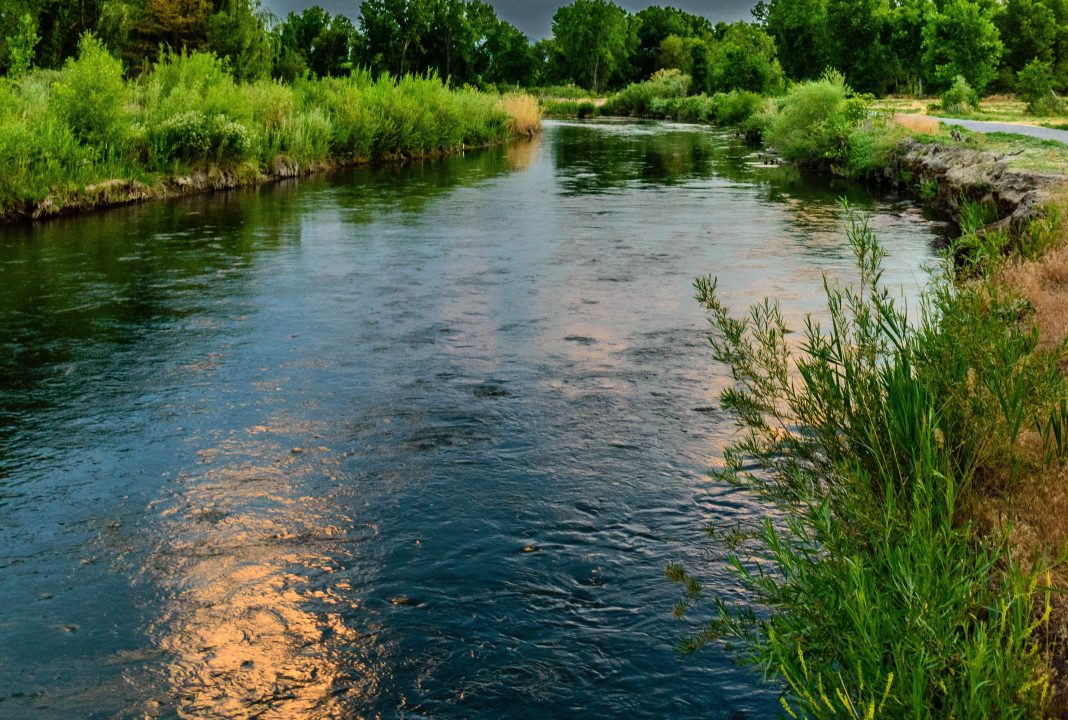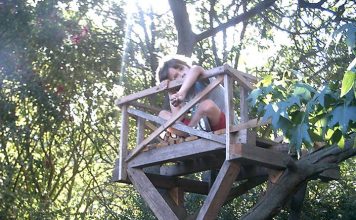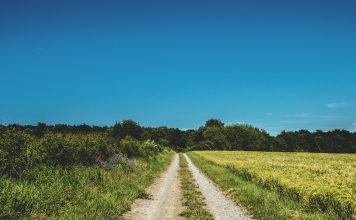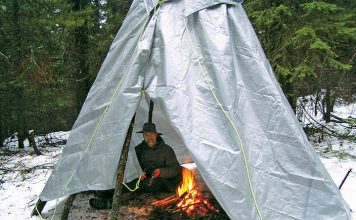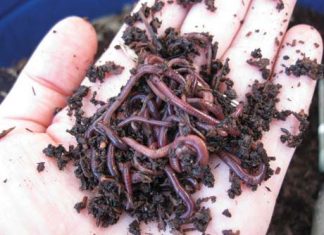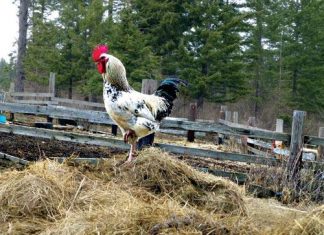 |
|
| Issue #144 • November/December, 2013 |
It is the most necessary of homestead requirements: water. It is literally a make-or-break resource.
There are some parts of our country blessed with an abundant and never-ending supply of water. These areas receive plentiful rainfall and/or have springs or other groundwater sources that never fail. To those homesteaders fortunate enough to live in such places, congratulations.
But for many other locations, water is a constant source of concern because it’s either undependable, less than pure, and/or hard to find (or reach). Most of these places, it seems, are where population is low and therefore particularly attractive to homesteaders who yearn to settle far away from the city lights. To these folks I say, be careful. A cavalier attitude toward water can spell disaster for your homesteading plans.
I confess I never gave much thought to the issue of water before moving rural, 23 years ago. In the city, water is just there. When you turn on your faucet, it issues forth, clean and potable, without fail. Growing up in California, we paid attention to governmental pleas to conserve water whenever there was a drought (which was most of the time), but by and large I never doubted that I could fill my glass whenever I wanted.
But gradually, as my husband and I embarked on our newly-married life in the city, we began asking a series of “What if?” questions. Such as, “What if city water wasn’t available? How would we survive?” In this day of increased awareness about disruptions in city services caused by anything from natural disasters to terrorism, it doesn’t take a rocket scientist to deduce that urban water sources are vulnerable to interruptions.
These kinds of concerns ultimately led us to leaving the city and embarking on our first rural adventure in 1993. Thus began our education on the need and availability of this critical resource.
This article cannot be entirely comprehensive in addressing everyone’s water issues. Your situation will depend on your rainfall, climate, soil and groundwater conditions, and finances. Hopefully, this article will allow you to better assess your situation and determine what action you need to take in order to secure a regular source of water.

Count yourself lucky if you have a river on your homestead. This is one of two rivers that runs through managing editor Annie Tuttle’s property.
Variable criteria
The trouble with discussing the issue of water is the vast number of variables involved. Is your property bare or developed? Is your home off-grid or on conventional power? What is your annual rainfall? Is your rainfall seasonal or year-round? What is your water source — well, pond, creek, spring, runoff, hauled in? What is your anticipated water usage — household use only, small garden, large garden, livestock, irrigation? What are your storage options — jugs in the basement, cistern, storage tank, pond, elevated gravity-fed tank? What are the practical alternatives to address water issues? And can you afford them?
Your budget will help determine solutions to your water challenges. By “budget” I mean everything from where and how much property you purchase, to what kind of backup water systems you’re able to afford.
Our story
Our first rural home was in southwest Oregon. The region had cool rainy winters and hot dry summers. The property had an 11 gallons per minute (gmp) well 80 feet deep. Urban novices though we were, we knew enough to have the well capacity as well as water quality tested before we made an offer on the house. We lived in that house for ten years and never (well, rarely) gave the well another thought. The water was delicious, dependable, and abundant.
Ten years ago we moved to rural north Idaho (with cold snowy winters and warm dry summers) and suddenly the issue of water played a much larger part in our lives.
This time we were a little less diligent about researching the well. We knew the well flowed at a decidedly modest 4 gpm and was a dazzling 590 feet deep, but we made the mistake of taking the seller’s word about dependability. Our biggest concern was whether or not the well could go dry, but the sellers assured us that had never happened during their ownership. Still, we could get by on 4 gpm, and the house and property was otherwise suited to our needs. So we made an offer, clinched the deal, and a short time later moved in.
Two weeks later, the well went dry.
It went dry literally in the middle of a shower. Grumpily I toweled the sticky soap from my skin and my husband and I wondered what the heck to do.
In talking with neighbors, we basically learned the sellers had lied to us. It turns out the well often went dry. In fact, it went dry so frequently that there was a well-sharing clause with the neighbor’s house, with the piping already in place. Our new neighbors kindly allowed us to renew the well-sharing and we paid them a monthly fee. This arrangement lasted for an entire year while we scraped together the money for a new well.
We had two drilling options for the well. Option One: We could drill an entirely new well at a cost of approximately $15,000. Option Two: We could re-drill the existing well and deepen it further, at an approximate cost of $7,000. While Option Two sounds like the logical choice, the trouble was there was no guarantee of hitting water, in which case we would have to fall back to Option One and pay for both scenarios.
We decided to take Option Two. The reason behind this calculated risk was because my husband (an engineering geologist by education) pulled the well logs for all the neighboring six properties and found that there was a fairly consistent and abundant water table at approximately 600 feet deep. Our existing well was 590 feet deep.
Could it be the original drillers had come up a mere ten feet short of punching through into the aquifer? It was certainly possible, since our well was the first one drilled in our neighborhood, 15 years before. The original owner had no way of knowing that more water was available just a bit deeper.
The well drillers arrived, they drilled out the old PVC pipe, and then continued to drill downward. Sure enough, at almost exactly 600 feet in depth — ten feet deeper than the original well — they punched through into a beautiful aquifer. Our well suddenly gushed at 30 gallons per minute. Eureka!
To be safe, the drillers went down another ten feet for a total depth of 610 feet. They re-inserted the original well pump (which, ironically, only pumps 5 gallons per minute) and we haven’t had a stitch of trouble with our well ever since.
But the depth and vulnerability of our deep well has never left the backs of our minds. When the power goes out, we lose water because we lose the well pump. We’re high on the prairie, ground water is very deep, and we have no springs or streams. Hand pumps aren’t possible at that depth. For years we investigated wind and solar alternatives. There are some arrays that could service a well that deep; but we didn’t have the money to pay for them. So our search for an alternative water source continued.
A few years ago we sprang for a 1500-gallon above-ground water tank, with the idea that we would hook it up to roof runoff. This will provide us with drinking and wash water but won’t be sufficient to water a garden or our livestock.
Our final solution (to date) was to dig a stock pond, which was actually more economical than we anticipated (more on this later).
So, after 10 years and a lot of thought, we now have three backup water sources (we call this the Rule of Three — backups to the backups to the backups) on our homestead. First backup: Stored water (about 40 gallons) for immediate use. Second backup: 1,500-gallon water tank for household and limited stock water. Third backup: a stock pond along with a pump and filter system for household use, stock water, and garden water.

Our well hasn’t given us any trouble since drilling it deeper, but when the power goes out, we lose water because we lose the well pump.
Water sources
There are three primary sources for water: rainfall, groundwater, and surface water.
Rainfall. The advantages of rainfall are obvious. It’s free, it’s available, and it blankets everything. Depending on climate and location, even arid places often receive enough rainfall to harvest for homestead use, such as capturing roof runoff into cisterns, rain barrels, or other catchments. Sadly, there are some places where local governments place restrictions on such practices, so check your local rulings before harvesting rainwater.
The most obvious catchment system for rainwater is roofing. A roof is a large and relatively clean flat surface with (hopefully) a non-leaking and water-shedding composition. Catchment systems are fairly easy to set up, merely gutters leading to a holding tank, cistern, or pond. If your rainfall is seasonal, your catchment system can be designed with enough capacity to get you through the dry season with normal usage. Keep in mind the needs of your garden and/or livestock.
Groundwater. Groundwater can only be accessed with a well. In pioneering days, a well was hand-dug and of necessity fairly shallow. It was usually about three feet wide and accessed with a bucket and windlass; or later, with a hand pump. Our old house in Oregon had such a hand-dug well, a beautiful stone-lined antiquity located under the front porch. If you’re lucky enough to have such a well, I suggest keeping it available for emergency use, and to keep a stout cover over the top to keep out animals, pets, children, and contaminants.
Today most wells are drilled and are about four to six inches in diameter, typically cased with PVC pipe. An electric well pump, located either adjacent to the well-head or at the bottom of the well, will deliver the water to your home. Wells have three measurements to consider: depth, flow rate, and static water level. The depth is just that — how far down the drillers needed to go in order to reach the aquifer. Flow rate is how many gallons per minute seep into the well hole. Static water level is how far up the well hole the water is pushed after whatever confining layers above the water table have been breached. In our case, our well is 610 feet deep with a flow rate of 30 gpm and a static water level of about 450 feet.
Static water level is important to know because if you need to hand-harvest your well water using a well bucket, sometimes called a well cylinder, you’ll need to know what kind of distance you’ll be pulling upward. Sometimes the static water level is too deep to efficiently use a well bucket, other times it’s not.
If your static water level is not too deep, a hand pump can be a lifesaving device for times when you’re without power (or live off-grid). However, hand pumps, which move water mechanically, are limited in effectiveness by static water level depth. If the static water level is greater than 200 feet, the water column (the amount of water in the pipe) is too “heavy” to lift; and the force required to lift water from that depth will be too great for practical use.
Aside from a standard AC electrical pump, for deeper wells (such as ours) there are really only two other practical options for bringing water to the surface. One is a solar array to power a specially-designed electric well pump; and the other is a windmill to pump the water to the surface mechanically
Windmills are highly effective and relatively simple (meaning, less maintenance) devices for pumping water from deep sources. The downside for us was price. We investigated a windmill for our needs and were quoted a price of $18,000, which I believe was reasonable. The trouble is we don’t have $18,000 lying around, so we were unable to take advantage of that option.
It also goes without saying that a windmill will do you very little good if you live in a place that gets no wind.
Alternately, a solar rig can be set up to power just the well pump (as opposed to powering an entire household). This consists of a solar panel hooked to a submersible well pump. Prices are more affordable than a windmill, though its more complex nature may mean greater maintenance. And for a consistent flow when the sun isn’t shining, a bank of batteries is necessary.
In both these cases (windmill or solar power), it would be best to talk to a knowledgeable sales rep from a specialized retailer about your specific needs. Both options have a long and well-established history of providing water in remote or difficult locations (think Texas hill country or Australian Outback) and are well worth the price. As a reminder, though, if the wind isn’t blowing or the sun isn’t shining, eventually the well is useless.
Surface water. If available, surface water is a tremendous blessing. A pond, spring, or stream can be used for either emergency household use (filter as necessary) or for everyday livestock and garden use. Once again, there may or may not be governmental restrictions on the use of surface water, so you need to research with due diligence whatever local restrictions may be in place.

An above-ground water tank can be used to store rain runoff from the roof.
How much water do you need?
If you’re like us, your daily indoor water usage can be very modest, far below the national average of 80 to 400 gallons per day (depending on which sources you consult). Perhaps you reduce your water usage through such water-saving devices as low-flow shower heads, composting toilets, and efficient washing machines.
However be careful of judging your homestead water needs by your indoor use. If you have livestock and/or a garden, your water usage will increase, often dramatically. I have a quarter-acre garden which must be watered daily during the dry summer months, a process that takes two hours. If we estimate three gallons per minute during the watering process, this comes to about 360 gallons per day just to water the garden. We are looking to make the garden more efficient in both time and water usage by installing a drip irrigation system. Mulching also greatly assists in reducing evaporation and reserving water. Nonetheless, a garden requires water. So do livestock. Can’t escape that.
These considerations must be factored in when calculating the amount of daily water you have available from a well, spring, roof runoff, or especially if you’re trucking in water.
So let’s do a modest exercise. I will try to estimate how much water our family of four uses on a typical hot summer day, both indoor and outdoor use.
| Washing dishes: 10 gallons. Washing a load of laundry: 25 gallons. Four showers: 40 gallons (low-flow shower head) Toilet flushing: 25 gallons Drinking: 2 gallons. Livestock: 100 gallons Quarter-acre garden: approximately 350 gallons TOTAL: 552 |
Now let’s multiply that amount through three dry months (90 days): 49,680 gallons. This is the amount of water, in theory, our homestead would need over the course of a typically dry summer. Fortunately, it’s rare in our region to have 90 straight days without rain; but that’s extremely typical for such places as southern Oregon or central California.
This is why it’s useful to employ catchment systems such as a house or barn roof. If we were to utilize our barn roof and catch rainwater, how much water could we expect?
Our barn is 36×48 feet. Each roof side is approximately 912 square feet in size. During a medium-sized rainstorm in which a quarter-inch of rain falls, this means 38 cubic feet or about 290 gallons can run off the roof and into a cistern or pond. Multiply this through additional rainstorms, and we have a decent amount of water available before the dry months hit.
That’s why catchment systems are so useful in drier climates. A large cistern or (better) a stock pond can greatly alleviate water woes and allow ample opportunity to keep your livestock and garden happy.

Dorothy Ainsworth’s water system includes a tank that she built herself and a water pumping windmill. Note the flag that is on a float in the tank. Dorothy can tell at a glance what the water level is in the tank.
Look before you leap
Those who already have their homesteads have doubtless given a great deal of thought to water. But what about those who are trying to get into the homesteading lifestyle? What should you consider before purchasing a piece of property to fulfill your homesteading dreams?
Moving water uphill
Some people may be fortunate enough to have a rapidly-moving creek or stream downhill from where they need water. What happens if you want to pump water uphill to water your garden or supply your household?
A centuries-old technique is to use a ram pump, which is powered by the kinetic energy of the flowing water itself. Commercially-made ram pumps are available for around $600. For do-it-yourselfers, there are online plans and instructions that allow you to build a ram pump with materials commonly available in hardware stores for around $100 or less.
The fact of the matter is, water is too critical a component of any homestead to skimp on proper research and forethought. Before buying a piece of bare land, for example, get a serious and reputable quote for how much it will cost and/or what it will take to develop a dependable source of water. Far too many city folks buy their piece of rural property for a song, and then are dismayed to learn it will cost thousands or tens of thousands of dollars to sink a well, buy and install a pump, and install a pressure-tank controller… as well as the necessary plumbing.
But as our story demonstrates, even developed property can have water problems. Springs, wells, and creeks can all go dry. The old “Rule of Three” applies just as much to water sources as to anything else.
If you’re just beginning your homesteading journey and are looking for suitable land, water availability should be your primary consideration. In some dry places, I know of people who haul in water from a distant location once or twice a week, but I find that option a little scary. What happens if your vehicle breaks down or you can’t get gasoline to power your vehicle or the distant water source is no longer available?
We also know some people who have taken the windmill and solar route for providing water from their deep well. Additionally, they’ve taken the precaution of digging a stock pond. In short, they are capable of obtaining water, whether on or off-grid.
I truly believe it’s vital that every homestead have a non-electric water source. If you have a spring or year-round stream or pond or other surface water, make sure you have the means to filter it for safe drinking. Alternately, look into harvesting roof runoff (again, with the means to filter it). If your well is not too deep, get a hand pump for those times when there is no power available for the electric pump to function.
Remember that cities are thirsty, thirsty entities, and are famous for usurping water rights from rural areas in order to fill swimming pools and provide green golf courses. In some classic examples, farmers were literally left with dust in their fields while their water rights were diverted to the nearest big city. Keep this in mind before purchasing property with no natural water source.
It is essential that you investigate the water rights for a piece of property prior to purchasing — and make sure those water rights stay in your name for the lifetime of your property ownership.
Well contaminants
Before purchasing property with a well, it is important to get the water tested for contaminants. Private wells are not covered by the EPA regulations that protect public drinking water systems. It is the buyer’s responsibility to test well water.
Well water can become contaminated either through naturally-occurring chemicals and minerals, or through man-made issues (herbicides, pesticides, animal feed operations, malfunctioning wastewater treatment facilities, etc.). While shallower wells are more subject to surface contamination, deep wells are affected by anything impacting the water table or aquifer.
Some of the common contaminants tested on private wells include coliform bacteria, nitrates, and volatile organic compounds.
Well buckets

You may have to haul water to your homestead as Jackie Clay did at one time.
If your water source is a well and the depth is too great to allow for a hand pump, a common emergency backup to get water from the well is a well bucket, sometimes called a bullet or torpedo bucket.
Modern wells usually have casings ranging from four to six inches in diameter, which makes for very narrow conditions for alternate water capture. You can’t just drop a bucket on a rope down the well and hoist water aloft.
Well, actually you can… but it takes a specialized bucket to fit within modern wells. A well bucket is a metal or PVC tube narrower than the interior diameter of the well casing. At the bottom is a flap valve which opens and allows water to enter the tube, and then seals shut by the weight of the water as the tube is lifted out of the well.
The amount of water lifted with a well bucket depends on the diameter and length of the tube. For example, a well bucket 52 inches in length and 3.5 inches in diameter will hold 1.9 gallons. Commercially-made well buckets are sold in many places online, but they are also easy to make from readily-available parts at any hardware store.
Depending on the depth of your well, a well bucket may require a windlass in order to more efficiently bring up water. Our well is 610 feet deep with a static water level of 450 feet, and a windlass will make the task of using a well bucket infinitely easier. Make sure you have adequate lengths of paracord or other sturdy nylon cordage on hand to lower the bucket to the depth of the static water level.
However, using a well bucket is not a simple matter of dropping a bucket into a hole. You must first remove the existing electric well pump and piping in order to have room for the well bucket. For this reason, a well bucket would only be practical during a long-term power outage and not during a blackout of short duration. Keep stored water on hand for temporary power outages.
By the way, if your well is less than 200 feet deep, consider getting a hand pump for alternate water access. While expensive, they are reliable and efficient.
Consider a stock pond
If water is not abundant in your area, you may have to create your own abundance. In north Idaho where we can easily go three months (during the summer) utterly without rain, we solved our long-term water needs by digging a stock pond.
There is a reason stock ponds are popular in the dry western half of the U.S. — they are a manmade but very necessary reservoir of (mostly) surface runoff for agricultural or fire control needs.
In our case, with a very deep well, no consistently-available surface water, and dry summers, we knew we needed a steady backup source of water for both our livestock and for our extensive garden. A pond fit those needs. It would also serve as a last-resort solution to household drinking and washing needs.
Accordingly, we knew the pond had to be located in a place convenient for all these needs (garden, livestock, household). It would be difficult to take full advantage of a pond’s potential if it were located a quarter-mile away.
My husband, who has a fair bit of engineering experience, considered the location of the pond carefully. In addition to proximity to the house, garden, and livestock, the pond needed to be on a fairly flat piece of land with a slight slope. Most importantly, my husband considered the soil conditions in our target area — a spot that was mostly clay would hold water without the need for a lining.
But no matter how much forethought went into the pond, we didn’t know what was actually underground until the digging began.
We decided on a square 50×50-foot pond, about 13 feet deep at one end and shallow at the other. We engaged the services of a skilled contractor with a track hoe. This man had long experience in building stock ponds, and he would know within a few minutes of breaking ground whether the pond would hold water or not. To our relief, the clay went down greater than the pond depth, making for a very watertight hole.
A neighbor, impressed with our aquatic undertaking, decided to have the same equipment operator dig him a pond as well. The neighbor chose a spot in a draw which would provide ample rain runoff. However, the subsurface proved to be too rocky and would not retain water, so the neighbor was forced to relocate the pond closer to his house on high ground, which had a similar clay layer to us. That pond was successful.
Initially, we thought our pond would need to be filled by shunting roof runoff from the barn. However, the clay layer proved useful in that the surface water funneled itself into the pond without any effort on our part. It has remained nearly full throughout the driest summer months and is a valuable addition to our homestead. At its fullest, we estimate the pond holds about 85,000 gallons of water.
Not everyone is blessed/cursed with heavy clay soil, however. If your subsoil stratum consists of limestone, sand, or some other porous medium, you’ll need to line the pond. If the pores are small enough, a layer of bentonite may be used. Bentonite is an absorbent clay that swells upon contact with water and forms an impermeable barrier, rendering a pond watertight. Bentonite can also be “sandwiched” between synthetic materials (plastic or vinyl) to line a pond.
If the substratum is too porous for bentonite, then a pond liner (a thick layer of plastic, rubber, or vinyl) may be necessary to hold water. These are available commercially. For smaller ponds, an old billboard tarp (available online) may suffice as a liner.
A couple of final notes on stock ponds. First, our pond cost a lot less than we thought it would. We contracted with the track hoe operator during his off-season (January) when he was willing to do the job for less than he might otherwise charge during his busier season. He dug us a 50×50-foot hole in the ground for $1000. It took five hours of actual digging time.
It is also important to realize that, at first, our “pond” was nothing more than a great big hole in the ground. A pond is not a proper pond until (a) it’s full (duh) and (b) it has an inflow and an outflow. Inflow proved to be easy due to surface runoff. But for a pond to be healthy, it needs an outflow. Therefore a pipe needs to be buried on the downhill side of the pond that will allow for controlled outflow to limit erosion.

We solved our long-term water needs by digging a stock pond.
Water purification
There may come a point where you need to filter or purify water for safe drinking, such as when the power is out, your well doesn’t work, and you need to use surface water. Whatever the circumstances, it’s important to keep a number of filtering or purification methods on hand.
First of all, don’t think it’s macho to cup your hands over a mountain stream and drink deeply. No matter how pure the water may look, you never know if there’s a dead elk upstream just around the bend, rotting in the water and contaminating it for a long distance downstream. Believe me, a bout with Giardia or dysentery is no picnic.
There are a number of effective ways to purify water, including boiling, filtration, and chemical treatments. These methods are effective for typical surface water such as ponds, puddles, roof runoff, streams, and lakes that may have viral or bacterial pathogens. Often it is recommended to combine two or three purification methods for greatest efficacy and safety. These methods assume the water has no chemical impurities such as toxic waste or pesticides/herbicides.
Boiling is an acceptable and age-old method of water purification. Bring water to a rolling boil (cover the pot for the greatest efficiency) for at least one minute. A rolling boil doesn’t mean tiny bubbles; it means the water is furiously boiling.
Filtration can be as simple as pouring water through a folded bandana (known as membrane filters) or as comprehensive as pumping water through a carbon or ceramic filter (known as depth filters). If the water is muddy or cloudy or has debris in it, it is best to filter out as many impurities as possible by membrane filtration before using an additional purification method. Your choice of depth filter may depend on what types of organisms are most common in your area.
For household (as opposed to backpacking or camping) use, a freestanding filter such as a Berkey unit is an excellent means of passively filtering water.
Bio-sand filters are an excellent passive filtering technique. They are the modern modification of the slow-sand filter technique that’s been in use for centuries. Bio-sand filters remove pathogens and sediments and are becoming common in developing nations. Plans can be found online and bio-sand filters can often be constructed for less than $100 using a 55-gallon drum. YouTube has a number of clips on how to make bio-sand filters.
Chemical purification is done using chlorine (bleach) or iodine. Effectiveness of chemical purification depends on a number of factors, including temperature, pH, and clarity of the water. Cooler and/or cloudier water requires higher concentration of chemicals to disinfect it.
If you use household bleach, it should not be scented, colorsafe, or have added cleaners. It should be less than a year old (or it loses efficacy) and 5.25% sodium hypochlorite. Add bleach at the rate of 16 drops per gallon of water. Stir and let stand for 30 minutes. If the water does NOT have a slight bleach-y odor at the end of 30 minutes, repeat the dosage and let stand another 15 minutes.
Iodine is another method for purifying water, but overall it is less recommended than bleach. Iodine is light-sensitive and should be stored in a dark bottle. It works best if the temperature of the water is 68° F or higher. While iodine is better than bleach at inactivating Giardia cysts, many people are allergic to iodine (often the same ones who are allergic to shellfish). Iodine should not be used by pregnant women.
If using liquid 2% tincture of iodine, add 5 drops per quart when the water is clear, 10 drops per quart when the water is cloudy. Shake and let sit for one hour. If using another form of iodine, follow the manufacturer’s instructions.
Rule of Three
As mentioned earlier, you should employ the “Rule of Three” for water. This means three backups to your main water supply.
In our situation, our main water supply is through our well, powered with an electric pump. Our three backups, both current and nearly completed, are:
- Stored water. We have about 40 gallons of water in either one- or five-gallon jugs with a bit of added bleach. We rotate this water once a year. We also have four or five gallons stored without bleach, which we rotate more frequently. This allows us immediate water during short-term power outages.
- A 1,500-gallon water tank. This will be hooked up to roof runoff from our barn, and used for longer-term household and livestock use.
- A 50×50-foot stock pond. This can be used for watering the livestock and garden and, during a long-term emergency, household use after proper filtering. We also have a Berkey filter and are working on a bio-sand filter.
You should have water sterilization or filtering options on hand at all times. Bleach, water purification tablets, and/or a water filter (such as a Berkey) are all necessary items.

Many filtration systems are do-it-yourself.
Annie Tuttle installed this water filtration system on her farm.
Miscellaneous points
- Remember, water weighs about eight pounds per gallon.
- When storing drinking water for emergency household use, darkness is essential to discourage the growth of algae and bacteria.
- Never believe a realtor who claims a piece of property has a “year round” creek or stream. A great majority of creeks and streams dry up in the hot dry months. Realtors may not know whether a stream is seasonal or not.
- Ditto this caution about sellers — they may not be entirely forthcoming about a well’s reliability. Test the well before you submit to buying a property.
- It might be illegal to irrigate a field from a well designed for household use. Irrigation rights are different than household water rights. Part of the reason behind this is irrigation may deplete water availability for your immediate neighbors. When water is pumped out of the ground too rapidly, it creates a “cone” of temporary deprivation that may affect the water flow into the neighbor’s well. Quite simply, if you try to irrigate a corn field out of a well, you may be causing your neighbor’s well to run dry.
- There are riparian laws in effect in many parts of rural America that limit the proximity of livestock to water (streams, creeks, rivers, ponds). Herbivorous consumption can damage delicate riparian areas by waterways, and hooves can contribute to bank erosion. You may have to install fences to keep your livestock away from surface water sources.
- The EPA estimates that 37% of household water is used to flush toilets. If you live in an area with limited water, consider a composting toilet.
- Just because you live rural doesn’t mean your surface or groundwater is pure. Agricultural chemicals (fertilizers, pesticides, etc.) as well as livestock waste contaminate enormous amounts of water. Modern farming techniques, thankfully, are working to minimize these contamination sources, but pollution still happens. Even the rock salt used to improve conditions on snowy roads is washed into the regional drainage systems and can contaminate water.
- Always assume that surface water is contaminated. Giardia is a common protozoan that can cause multiple complications in people who get infected. Something that died upstream and fell into the water can make even the purest-looking downstream water deadly.
- While shallow wells have multiple advantages for getting water to the surface, they can also be more subject to contamination. Deep wells, more complicated to access, usually (but not always) have the advantage that the water is generally purer.
- Some locations in proximity to the ocean may be subject to saltwater intrusion at certain times (high tide, etc.) or to sinkholes.
- The Internet (including YouTube) is the modern homesteader’s best friend when it comes to learning specifics about certain projects such as bio-sand filters or ram pumps. Make lavish use of someone else’s expertise!
In conclusion…
Back in the old days when we lived in the city and began thinking through all those “What if?” questions, we were stymied because any solutions or backups (except for some personal water storage) depended on someone else to provide. But here in the country, it’s up to us to provide our own water under whatever circumstances.
There’s a rule of thumb called three-three-three. You can only live three minutes without oxygen, three days without water, or three weeks without food. Assuming your homestead has air, your greatest immediate concern is water.
Make sure you’ve got it.


